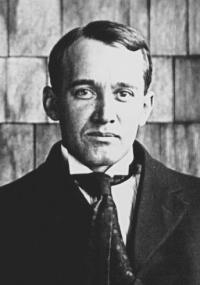1935
“V.M.” Slipher was born in Indiana and educated at Indiana University. His entire career was spent at the Lowell Observatory, where he started immediately after receiving his A.B. in 1901 and which he directed from 1916 to 1954. His visible and infrared spectroscopic studies of planets led to the determination of rotation periods— he made the first spectroscopic measurement of the rotation period of Uranus, he showed that Venus must rotate very slowly— and he identified molecules in planetary atmospheres. He discovered reflection nebulae and confirmed the existence of interstellar dust and gas. Using exposure times as long as 80 hours, he was the first to measure the enormous radial velocities of spiral nebulae, showing that most were receding from the solar system and providing important support for the then-controversial view that they were far outside our Galaxy. These data were later used and extended by Edwin P. Hubble to begin modern observational cosmology. Slipher discovered and measured the rotations of the spirals. He also made extensive studies of the spectra of the night sky and the aurorae. As director he organized and supervised the successful search for a ninth planet.
Presentation of Bruce medal
Einarsson, S., PASP 47, 5-10 (1935).
Other awards
French Academy of Sciences, Lalande Prize, 1919.
National Academy of Sciences, Henry Draper Medal, 1932.
Royal Astronomical Society, Gold medal, 1933, presented by F.J.M. Stratton, MNRAS 93, 476-77 (1933).
Biographical materials
Giclas, Henry L., Biographical Encyclopedia of Astronomers (Springer, NY, 2007), p. 1066.
Hart, Richard & Richard Berendzen, Dictionary of Scientific Biography 12, 454-56.
Hoyt, William Graves, Biographical Memoirs of the National Academy of Science 52,410-49 (1980).
Smith, Robert W., “Red Shifts and Gold Medals: 1901-1954,” in William Lowell Putnam and others, The Explorers of Mars Hill (Phoenix Publishing, West Kennebunk, Maine, 1994), pp. 43 - 65.
Tenn, Joseph S., “What Else Did V. M. Slipher Do?,” in Origins of the Expanding Universe: 1912-1932, Michael Way and Deidre Hunter, eds. (Astronomical Society of the Pacific Conference Series, vol. 471, 2013), pp. 235-248.
Obituaries
Hall, John S., Sky & Telescope 39, 2, 84-86 (1970).
Hall, John S., Year Book of the American Philosophical Society 1970, 161-66.
Portraits
Lowell Observatory
Named after him
Martian crater Slipher*
Minor Planet #1766 Slipher*
*with his brother, Lowell Observatory astronomer E.C. Slipher
